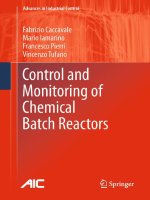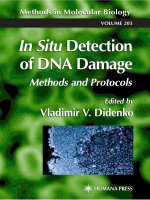Emerging and endemic pathogens advances in surveillance detection and identification NATO science for peace and security series a chemistry and biology
Bạn đang xem bản rút gọn của tài liệu. Xem và tải ngay bản đầy đủ của tài liệu tại đây (5.56 MB, 165 trang )
Emerging and Endemic Pathogens
NATO Science for Peace and Security Series
This Series presents the results of scientific meetings supported under the NATO
Programme: Science for Peace and Security (SPS).
The NATO SPS Programme supports meetings in the following Key Priority areas:
(1) Defence Against Terrorism; (2) Countering other Threats to Security and (3) NATO,
Partner and Mediterranean Dialogue Country Priorities. The types of meeting supported
are generally "Advanced Study Institutes" and "Advanced Research Workshops". The
NATO SPS Series collects together the results of these meetings. The meetings are coorganized by scientists from NATO countries and scientists from NATO's "Partner" or
"Mediterranean Dialogue" countries. The observations and recommendations made at
the meetings, as well as the contents of the volumes in the Series, reflect those of participants and contributors only; they should not necessarily be regarded as reflecting
NATO views or policy.
Advanced Study Institutes (ASI) are high-level tutorial courses intended to convey the
latest developments in a subject to an advanced-level audience
Advanced Research Workshops (ARW) are expert meetings where an intense but
informal exchange of views at the frontiers of a subject aims at identifying directions for
future action
Following a transformation of the programme in 2006 the Series has been re-named and
re-organised. Recent volumes on topics not related to security, which result from meetings
supported under the programme earlier, may be found in the NATO Science Series.
The Series is published by IOS Press, Amsterdam, and Springer, Dordrecht, in conjunction
with the NATO Public Diplomacy Division.
Sub-Series
A.
B.
C.
D.
E.
Chemistry and Biology
Physics and Biophysics
Environmental Security
Information and Communication Security
Human and Societal Dynamics
/>
Series A: Chemistry and Biology
Springer
Springer
Springer
IOS Press
IOS Press
Emerging and Endemic
Pathogens
Advances in Surveillance, Detection
and Identification
edited by
Kevin P. O’Connell
U.S. Army Edgewood Chemical Biological Center
Aberdeen Proving Ground, MD, USA
Evan W. Skowronski
U.S. Army Edgewood Chemical Biological Center
Aberdeen Proving Ground, MD, USA
Alexander Sulakvelidze
University of Florida
Gainesville, FL, USA
and
Lela Bakanidze
National Center for Disease Control
Tbilisi, Republic of Georgia
Published in cooperation with NATO Public Diplomacy Division
Proceedings of the NATO Advanced Research Workshop on
Advances in Surveillance, Detection and Identification of Emerging
and Endemic Pathogens
Tbilisi, Georgia
24–26 June 2008
Library of Congress Control Number: 2010934368
ISBN 978-90-481-9639-5 (PB)
ISBN 978-90-481-9636-4 (HB)
ISBN 978-90-481-9637-1 (e-book)
Published by Springer,
P.O. Box 17, 3300 AA Dordrecht, The Netherlands.
www.springer.com
Printed on acid-free paper
All Rights Reserved
© Springer Science + Business Media B.V. 2010
No part of this work may be reproduced, stored in a retrieval system, or transmitted
in any form or by any means, electronic, mechanical, photocopying, microfilming,
recording or otherwise, without written permission from the Publisher, with the
exception of any material supplied specifically for the purpose of being entered and
executed on a computer system, for exclusive use by the purchaser of the work.
Preface
It is a truism among biologists that an organism’s phenotype is the product of both its
genotype and its environment. An organism’s genotype contains the total informational
potential of the individual, while its environment shapes the expression of the genotype, influences the rate of mutation and occurrence of modifications, and ultimately
determines the likelihood that the genotype (or fractions thereof) will survive into the
next generation. In the relationship between host and pathogen, therefore, each forms a
part of the environment of the other, mutually influencing the biology of both partners
on scales ranging from the life history of individuals to the fate of populations or entire
species.
Molecular biologists working on problems in pathogenesis generally think of the
host organism as the pathogen’s environment and perhaps occasionally consider the
pathogen as part of the host’s environment. However, because “environment” can be
defined at many scales, so, too, can phenotypes: if a pathogen, as a species, is considered to exist in a host, as a species, then among its phenotypes is the nature of the
pandemic disease it can cause within the host community. The contributors to the
proceedings of this NATO Advanced Research Workshop have treated the interplay of
environment and genotype in the host–pathogen relationship and its relationship to the
problem of emerging infectious disease at both the macroscopic and microscopic/
molecular levels along this continuum of scale (with some human history thrown in at
times for good measure).
Keynote Chapter
The contribution from the meeting’s keynote speaker highlights the importance of
understanding the underpinnings of pathogen phenotypes at both scales. The example
of Vibrio cholerae is considered macroscopically and genetically in an examination of
the factors influencing the emergence and spread of new strains of human bacterial
pathogens. Citrus greening, caused by the bacterium Liberibacter asiaticus and
vectored by the Asian citrus psyllid Diaphorina citri, is discussed to illustrate the effect
of a vector species’ biology on disease emergence and spread. An unfortunate lesson
from these examples is that diseases that have already emerged and have spread rapidly
may be difficult to control; however, any hope of disease control will be founded on an
understanding of the genetic and molecular basis for pathogenesis and the environmental
factors (including vectors) that contribute to the transmission of the microorganism.
Section I: Surveillance
The next four chapters treat country-specific approaches, and their results, in one of the
most fundamental tasks in combating emerging infectious disease: detecting and
v
vi
PREFACE
describing the incidence of disease in a geographic region. By its very nature, this effort
is labor-intensive in terms of fieldwork (both human and environmental) and in the
subsequent laboratory analysis of samples. In the Balkans, the Caucasus, and the
Central Asian republics, like elsewhere in the developed and developing worlds,
surveillance work ranges from the basic (trapping and culturing from members of a
reservoir species) to the complex (use of sensitive laboratory molecular methods, such
as PCR) and the application of the resulting data to forestalling and controlling the
outbreak of endemic diseases. Akimbayev et al., from Kazakhstan, and Gurbanov and
Akhmedova, from Azerbaijan, provide a description of surveillance efforts in recent
years that highlight the human and economic factors that influence disease transmission.
From the Republic of Georgia, Bakanidze et al. provide a historical perspective that
demonstrates the role that militaries have played in the development of public health
methods and practices, born of necessity: throughout history, armies over time have lost
more soldiers to disease than to violence. Complementing the paper by Bakanidze and
colleagues, the chapter by Zhgenti et al. reports on the use of modern molecular biological techniques to differentiate closely related strains of pathogenic bacteria isolated
from both environmental and clinical samples in Georgia and throughout the Caucasus.
Stikova describes a syndrome-based, nationwide effort deployed in the Republic of
Macedonia to report priority communicable diseases that is complementary to the routine
surveillance system that reports individual confirmed disease cases. This system, called
ALERT, aided in forecasting and detecting the start of the influenza season.
The goal of surveillance always has been actionable information that would allow
public health workers to forestall the spread of disease. “Classical” surveillance and
epidemiologic reporting as described in these first four chapters, however, now also
provides data that are being analyzed by advanced computational and geographic methods
known collectively as Geographical Information Systems. Blackburn rounds out
Section I by describing new tools that enable the fusion of climatologic, geographic,
and epidemiologic data with concepts in ecological niche theory to construct models
that may predict the future incidence, prevalence, and transmission of Bacillus anthracis,
but the methods are generalizable to other diseases.
Section II: Molecular Analysis and Tools
At the scale of the bacterium and bacterial genome, the contributors to this section each
provide an example of how cutting-edge molecular biological methods are being
applied to answer key questions in the study of emerging infectious disease.
How did the pathogens we observe in the world come to their present state?
Technical challenges abound in the analysis of biological specimens for evidence of
ancient infections. Aboudharam et al. describe the development of dental pulp as a
target material for isolation of bacterial DNA and the diagnosis of ancient bacteremias,
including Yersinia pestis infections. Key to their methodology is the development of
single-use primer pairs for the detection and amplification of ancient target sequences
in a method they term “suicide PCR.”
What determines the severity of disease a pathogen may cause? Perry et al.
demonstrate the utility of comparative genomics in identifying a putative hemagglutinin
gene (“Region E”) that is present in Brucella melitensis 16M and absent in Brucella
PREFACE
vii
abortus. The data suggest that “Region E” has a host-specific influence on virulence,
and the authors speculate that expressing the hemagglutinin in certain Brucella strains
may improve their performance as vaccines.
What genome-wide adaptations predispose a pathogen to cause severe disease?
Rakin examines the contributions of both gain-of-function genetic changes (via lateral
gene transfer) and negative selection (favoring what is termed pathoadaptive mutations)
in the evolution of pathogenic bacteria. His analysis points out the importance of
single-nucleotide polymorphisms that, besides being markers for strain identification,
can have significant effects on the functions of virulence and pathogenicity genes. The
implication of these results is apparent: in a selective environment or host, mutations
can occur that lead to a sudden emergence of a virulent bacterial strain.
What tools are available for practical studies when containment is not available or
practical, but safety must be maintained? Researchers have long used non-pathogenic
surrogates, or “simulants” in place of pathogens and protein toxins for reasons of convenience, safety, reduction of expense, and speed of work. Such simulants have included
benign enteric bacterial species, bacteriophage (especially MS2), and proteins such as
ovalbumin. Ouellette et al. review here information that suggest that baculoviruses, long
used in organic agriculture and widely regarded as having no ill effects on humans,
animals or plants, may serve as a new class of simulants for some viral pathogens.
How do recent advances in sequencing affect the genetic analysis of pathogens?
Molecular biologists are relying on the rapidly decreasing cost per base of DNA
sequencing to support the continuing effort to detect and identify the genes (as is
discussed by Perry et al.) or gene variants (as in Rakin) that influence bacterial pathogenicity and virulence. Khan briefly reviews the procession from Sanger dideoxy
sequencing (and the dye-coupled PCR-driven variant) to so-called next-generation
sequencing (NGS) methods. NGS methods have a much higher throughput than the
Sanger methods but with generally smaller average read lengths. Concurrent increases
in computational power allow the rapid querying of databases for bacterial identification.
However, although faster computation also speeds contig formation from unique
sequences, short read lengths can result in more contigs that require more effort to
assemble into finished whole bacterial genomes. Fortunately, complementary technologies
such as whole genome optical restriction mapping are emerging that very rapidly
provide the scaffolding data needed to match the increased rate at which NGS produces
contigs.
Bacterial genome sequencing that 15–20 years ago required years of effort now
takes weeks. The rate at which sequencing technology is accelerating has been compared
with Moore’s Law in computing power, except that the rate of improvement for
sequencing has proven to be steeper than the drop in the cost of memory and clock
cycles over time. The “next” in NGS likely is ready to become dated in use as single
molecule sequencing methods are being commercialized by at least two companies and
faster methods still are certain to follow.
No sequencing technology currently is employed widely outside of laboratories or
core facilities. However, entrepreneurs are fervently seeking the right combinations of
technology and business models that will put NGS (and beyond) into the hands of
nonlaboratory end users (clinicians, epidemiologists, law enforcement, and first
responders). The eventual goal is to provide a user with an encyclopedic understanding
viii
PREFACE
of the DNA sequences present in a sample, breaking the barrier that currently separates
sensitivity plus specificity from speed of analysis. The possibility of a technology that
will permit fast, accurate, complete data from genuinely unknown samples (unlike
PCR) may at last be on the horizon.
Acknowledgements
We gratefully acknowledge the assistance of the staff members of the Edgewood
Chemical Biological Center, the Georgian National Center for Disease Control, and the
University of Florida for their contributions to the success of this Advanced Research
Workshop, whose speakers contributed to this volume. We also thank the members of
the staff of ARW Secretariate for their tireless help with the logistical details of
the conference. In particular, we thank Geoff Doyle of SAIC, for his outstanding
organizational skills, and Rebecca Bryan for fellowship and her good humor as well as
expert assistance with innumerable tasks during the conference in Tbilisi.
In the production of the conference proceedings, the NATO Science Series staff, in
particular Ms. Wil Bruins, provided invaluable advice and assistance. Lastly, we thank
Jean McHale for the many hours spent editing, formatting and compiling the papers
included in this book. Without her expert help the publishing of this book of conference
proceedings would not have been possible.
ix
Organizers
Kevin P. O’Connell
Evan W. Skowronski
U.S. Army Edgewood Chemical Biological Center
Aberdeen Proving Ground, Maryland, USA
Alexander Sulakvelidze
Emerging Pathogens Institute
University of Florida
Gainsville, Florida, USA
Lela Bakanidze
National Center for Disease Control
Tbilisi, Republic of Georgia
Roger Hewson
Centre for Applied Microbiology and Research
Health Protection Agency
Porton Down, Salisbury, United Kingdom
xi
Speakers
Gérard Aboudharam
Faculté de Médecine
Universite de la Mediterranee
Unité des Rickettsies
Marseille, France
e-mail: gerard.aboudharam
@wanadoo fr
Philip Elzer
Department of Pathobiological
Sciences
School of Veterinary Medicine
Lousiana State University
Baton Rouge, Lousiana, USA
e-mail:
Alim Aikimbayev
Kazakh Scientific Center for
Quarantine and Zoonotic Diseases
Almaty, Kazakstan
e-mail: alim.aikimbayev@mail ru
Robert Esler
US Civilian Research and
Development Foundation
Arlington, Virginia, USA
e-mail:
Andrey Anisimov
State Research Center for Applied
Microbiology and Biotechnology
Obolensk, Russia
e-mail:
Jason Farlow
Arizona State University
Tempe, Arizona, USA
e-mail:
Giorgi Babuadze
National Center for Disease Control
Tbilisi, Republic of Georgia
e-mail:
Lela Bakanidze
National Center for Disease Control
Tbilisi, Republic of Georgia
e-mail:
Nelli Barnabishvili
National Center for Disease Control
Tbilisi, Republic of Georgia
e-mail:
Jason Blackburn
Emerging Pathogens Institute
University of Florida
Gainsville, Florida, USA
e-mail:
Stephen Francesconi
US Armed Forces Institute of
Pathology
Washington, DC, USA
e-mail:Stephen.Francesconi
@afip.osd mil
Amiran Gamkrelidze
United Nations World Health
Organization
Tbilisi, Republic of Georgia
e-mail:
Tatiana Gremyakova
International Science and Technology
Centre
Moscow, Russia
e-mail:
xiii
xiv
Shair Gurbanov
Azerbaijani Republic Antiplague
Station
Baku, Azerbaijan
e-mail:
Paata Imnadze
National Center for Disease Control
Tbilisi, Republic of Georgia
e-mail:
Akbar Khan
Defense Threat Reduction Agency
Fort Belvoir, Virginia, USA
e-mail:
George Khokhobashvili
Georgian Research and Development
Fund
Tbilisi, Republic of Georgia
e-mail:
J. Glenn Morris
Emerging Pathogens Institute
University of Florida
Gainsville, Florida, USA
e-mail:
C. J. Nutter
Defense Threat Reduction Agency
Fort Belvoir, Virginia, USA
e-mail:
Tinatin Onashvili
Laboratory of Ministry of Agriculture
Tbilisi, Republic of Georgia
e-mail:
Eka Paatashvili
Ministry of Health
Tbilisi, Republic of Georgia
e-mail:
SPEAKERS
Scott Petersen
J. Craig Venter Institute
Rockville, Maryland, USA
e-mail:
Alexander Rakin
Ludwig-Maximilians Universitat
Max von Pettenkofer-Institut
Munich, Germany
e-mail:
Daniel Rock
Department of Pathobiology
College of Veterinary Medicine
University of Illinois
Urbana, Illinois, USA
e-mail:
Elisaveta Stikova
Faculty of Medicine
University of St. Cyril and Methodius
Skopje, Republic of Macedonia
e-mail: mk
Nikoloz Tsertsvadze
National Center for Disease Control
Tbilisi, Georgia
e-mail:
Natalya Vydayko
Central Sanitary-Epidemiological
Station
Ministry of Health
Kiev, Ukraine
e-mail: vydaykon@ukr net
Eka Zhgenti
National Center for Disease Control
Tbilisi, Georgia
e-mail:
Other Participants
Wallace Buchholz
US Army Research Office
Research Triangle Park, North
Carolina, USA
e-mail:
Niko Burdiashvili
Georgian Research and Development
Fund
Tbilisi, Georgia
e-mail:
Geoffrey Doyle
SAIC, Inc.
Aberdeen Proving Ground, Maryland,
USA
e-mail: GEOFFREY.L.DOYLE
@saic.com
Ilya Elashvili
Defense Threat Reduction Agency
Fort Belvoir, Virginia, USA
e-mail: Ilya.Elashvili@dtra mil
Henry Gibbons
US Army Edgewood Chemical
Biological Center
Aberdeen Proving Ground, Maryland,
USA
mil
Roger Hewson
Centre for Applied Microbiology
and Research
Health Protection Agency
Porton Down, Salisbury, United
Kingdom
e-mail:
Evan Skowronski
US Army Edgewood Chemical
Biological Center
Aberdeen Proving Ground, Maryland,
USA
e-mail:
Revaz Solomonia
Ivane Beritashvili Institute of
Physiology
Tbilisi, Georgia
e-mail:
Alexander Sulakvelidze
Emerging Pathogens Institute
University of Florida
Gainsville, Florida, USA
e-mail:
David Gutierrez
US Army Edgewood Chemical
Biological Center
Aberdeen Proving Ground, Maryland,
USA
e-mail: mil
xv
Contents
Editor’s Preface
Acknowledgements
Organizers
Speakers
Other Participants
v
ix
xi
xiii
xv
Keynote Contribution
1
Global Effect and Prevention of Emerging and Epidemic Pathogens: Cholera
and Citrus Greening as Examples
J. Glenn Morris, Jr.
3
Section I: Surveillance
The Epidemiological Surveillance of Highly Pathogenic
Diseases in Kazakhstan
Alim M. Aikimbayev, Jumabek Y. Bekenov, Tatyana V. Meka-Mechenko,
and Gulnara A. Temiraliyeva
13
15
Surveillance on Plague in Natural Foci in Georgia
Lela Bakanidze, Paata Imnadze, Svetlana Chubinidze, Nikoloz Tsertsvadze,
Gela Mgeladze, Irakli Shalutashvili, Shota Tsanava, Merab Shavishvili,
Julietta Manvelyan, Nana Ninashvili, and Guram Katsitadze
21
Application of Modern Techniques for Studying Bacterial Pathogens in Georgia
Ekaterine Zhgenti, Gvantsa Chanturia, Mariam Zakalashvili,
and Merab Kekelidze
29
Especially Dangerous Infections in Azerbaijan
Sh. Gurbanov and S. Akhmedova
39
Strengthening the Early-Warning Function of the Surveillance System:
The Macedonian Experience
Elisaveta Stikova, Dragan Gjorgjev, and Zarko Karadzovski
Integrating Geographic Information Systems and Ecological Niche Modeling
into Disease Ecology: A Case Study of Bacillus anthracis in the United States
and Mexico
Jason K. Blackburn
45
59
xvii
xviii
CONTENTS
Section II: Molecular Analysis and Tools
89
Applications of Paleomicrobiology to the Understanding of Emerging
and Re-emerging Infectious Diseases
Gérard Aboudharam, Michel Drancourt, and Didier Raoult
91
Characterization of a Putative Hemagglutinin Gene in the Caprine Model
for Brucellosis
Quinesha L. Perry, Sue D. Hagius, Joel V. Walker, Lauren Duhon,
and Philip H. Elzer
99
Pathoadaptation of Especially Dangerous Pathogens
Alexander Rakin
109
Detection of Pathogens Via High-Throughput Sequencing
Akbar S. Khan
119
Environmental Influences on the Relative Stability of Baculoviruses
and Vaccinia virus: A Review
Gary D. Ouellette, Patricia E. Buckley, and Kevin P. O’Connell
125
Subject Index
151
Keynote Contribution
Global Effect and Prevention of Emerging
and Epidemic Pathogens: Cholera
and Citrus Greening as Examples
J. Glenn MORRIS, Jr.
Professor and Director, Emerging Pathogens Institute, University of Florida,
Gainesville, Florida
Abstract. Emerging and epidemic infectious diseases have had a major effect on
human history. We are just now coming to appreciate the mechanisms by which
new strains emerge and the factors that permit their rapid spread within human
populations. Cholera is a classic epidemic disease that causes periodic pandemics
(possibly reflecting genetic changes in surface antigens of the microorganism) and
seasonal epidemics that appear to be triggered by environmental factors. Citrus
greening is a plant disease that kills citrus trees; a vector-borne bacterial disease, it
is currently spreading rapidly across Florida. Control of these and other epidemic
and emerging diseases may be difficult, particularly if the infection is already
widespread in target populations. Any chance of successful control requires a
comprehensive understanding of the pathogenesis and transmission pathways of
the microorganism.
Emerging and epidemic pathogens have played a major role in human history. The
concept of plagues – infectious and otherwise – is deeply enmeshed in the Biblical story
of Moses, Pharaoh, and the departure of the Jewish people from Egypt in approximately
1300 BC. Cholera, with an ancestral home in the delta of the Brahmaputra and Ganges
Rivers, is noted in the Sushruta Samhita, written about 500–400 BC; this includes the
Sanskrit term generally used to refer to cholera as well as the description of a
representative case. Reports of cholera can be found in the Arab literature by 900 AD,
with descriptions subsequently appearing in European, Indian, and Chinese literature
[1]. Plague (caused by Yersinia pestis) was responsible for the Black Death of 1348–
1349, which has been called the greatest biomedical disaster in European and possibly
world history [2]. Epidemics of yellow fever in the United States were a major driver
for the creation of departments of public health beginning with the formation of the
Philadelphia Board of Health in 1794.
Although there is general familiarity with these “classic” epidemic diseases, recent
work by Jones and colleagues [3] suggests that the emergence of new pathogens is a
constant, ongoing process. Based on a literature review, these authors identified 335
infectious disease emergence “events” occurring between 1940 and 2004. Zoonotic pathoens (i.e., those that have a nonhuman animal source) predominated, accounting for 60.3%
of events; vector-borne diseases were responsible for 22.8% of events. The majority of
pathogens identified were bacteria or rickettsia (54.3%). Although some of these events
reflected small numbers of actual cases, it is clear that the potential for new disease
emergence – with the threat of subsequent epidemic spread – is always present.
K.P. O’Connell et al. (eds.), Emerging and Endemic Pathogens,
DOI 10.1007/978-90-481-9637-1_1, © Springer Science + Business Media B.V. 2010
3
4
J.G. MORRIS
There are a variety of factors that underlie the emergence of new pathogens.
Emergence of a pathogen may reflect genetic changes that result in increased virulence,
the ability to avoid immunologic detection by the host or killing by antibiotics, or the
ability to survive in new ecologic niches. Independent of genetic changes, there may
be changes in opportunities for pathogen growth and spread, often as the result of
anthropogenic (human-created) changes. This may include environmental changes
(such as temperature change), changes in ecologic niches, changes in host behavior,
and/or introduction of a pathogen into a new geographic area (intentional or otherwise).
Finally, pathogen emergence may be influenced by changes in host behavior, including
loss of herd immunity (such as the diphtheria epidemics that occurred in parts of the
former Soviet Union as a result of decreases in immunization rates) and immunosuppression (which may be related to disease, aging, and malnutrition) [4].
Why do pathogens emerge?
– Appearance of new/genetically different strains
– Changes in opportunities for pathogen growth and spread (often
anthropogenic)
– Changes in host susceptibility
1. Cholera: A Classic Epidemic/Pandemic Pathogen
Cholera remains the one disease that consistently can cause dehydrating diarrhea in a
healthy adult. The symptoms of cholera are caused by cholera toxin (CT), a protein
enterotoxin that elicits profuse diarrhea [5, 6]. Clinically, patients with the most severe
form of the disease can pass in excess of 1 L of diarrheal stool per hour; if fluid losses
are not replaced by oral or intravenous fluids, this can result in severe dehydration,
shock, and death in 12–24 h. With appropriate therapy, mortality rates for cholera
should be less than 1%. However, in the absence of an adequate public health
infrastructure to provide treatment, mortality rates may reach or exceed 40%. This is
reflected in the 2005 World Health Organization’s cholera-surveillance data (the most
recent available): 131,942 cholera cases were reported in 52 countries, the majority of
which had case-fatality rates below 1%; rates in excess of 1% occurred almost
exclusively in sub-Saharan Africa, with multiple countries in this region reporting rates
in excess of 5% [7].
Cholera is caused by strains of Vibrio cholerae that carry specific virulence factors.
The species V. cholerae is free-living in the environment, often associated with phytolankton and zooplankton, and is common in estuarine areas. Growth is dependent on
temperature (ideally >20°C) and salinity. Survival of the organism is facilitated by its
ability to shift to a rugose phenotype (Fig. 1), involving production of an amorphous
extracellular polysaccharide that serves as the basis for biofilm formation; rugose forms
are fully virulent but resist killing by chlorine and ultraviolet light [8]. Survival also
may be facilitated by the ability of strains to assume a viable but nonculturable form.
GLOBAL EFFECT AND PREVENTION
5
Figure 1. Smooth (left) and rugose (right) colony morphologies for Vibrio cholerae.
More than 200 O-groups have been identified for V. cholerae, with epidemic
cholera cases traditionally linked with O-group 1 (V. cholerae O1). Key virulence
factors necessary for occurrence of cholera include CT and associated genes (carried by
the CTX phage, which is capable of transfer among V. cholerae strains) and the vibrio
pathogenicity island, which includes genes for toxin-coregulated pilus, a key attachment
factor (and the receptor for the CTX phage). However, it appears that the ability to
cause epidemic disease is dependent on additional and still poorly charcterized factors. In
studies conducted in our laboratories using multilocus sequence typing (MLST), all
clinical cholera strains clustered into a single MLST clonal complex, consistent with
the hypothesis that strains capable of causing disease are closely related phylogenetically.
In contrast, there may be striking sequence divergence between epidemic cholera
strains and V. cholerae strains from other O-groups. In work that we have done with V.
cholerae strain NRT-36S, an O31 strain, we found only 89% sequence homology with
epidemic cholera isolates, with absence of a number of putative virulence genes [9].
Epidemiologically, cholera tends to occur in two patterns: it spreads in pandemic
form, moving across continents, and, after introduction into an area, it may settle into
an “endemic” pattern marked by seasonal epidemics. From the perspective of undertanding emergence of pathogens, this leads to two basic questions: what mechanisms
underlie occurrence of pandemic disease, and, once the pandemic wave has passed,
what are the triggers for recurrent seasonal epidemics?
1.1. Pandemic Cholera
The modern history of cholera begins in 1817 with the occurrence of what has been
designated as the first of seven cholera pandemics. It was during the spread of the third
pandemic to London in 1854 that John Snow demonstrated the association between
illness and consumption of sewage-contaminated water. His work established the role
of epidemiology in public health and highlighted the efficacy of simple interventions –
in this case the removal of the handle of the Broad Street pump, which had been linked
with illness. The seventh (and most recent) cholera pandemic began in 1961, with an
outbreak of disease in the Celebes. The strain responsible for this outbreak (V. cholerae
O1 biotype El Tor) subsequently has spread through Asia, Africa, Europe, and the
Americas, resulting in substantial global morbidity and mortality and leaving behind an
endemic pattern of seasonal epidemics (Fig. 2) [10].
6
J.G. MORRIS
Figure 2. Global spread of the seventh pandemic of cholera.
In 1992, against this background and outside of normal seasonal epidemic patterns,
cholera began to spread rapidly across India and Bangladesh, with subsequent spread to
other parts of Asia. In contrast to the traditional endemic pattern of cholera in these
areas, all ages were affected, suggesting a lack of preexisting immunity within the
population [11]. In subsequent studies, we and others found that the strain responsible
for this “new” epidemic was from a different O-group (O139), was encapsulated, and
had undergone a genetic substitution/deletion with the introduction of 35 kb of “new”
DNA encoding the O139 capsule, replacing 22 kb of “original” DNA encoding the O1
antigen [12, 13]. Aside from this one substitution, the epidemic strain appeared to be
identical to seventh pandemic V. cholerae O1 El Tor strains.
Further studies from our laboratory have shown that the gene cluster controlling
expression of the O-antigen and capsule is bounded consistently by two genes – gmhD
and rjg. Genetic substitutions within this region are not uncommon and may account
for the diversity of O-groups within the species [14, 15]. Although the initial epidemic
due to V. cholerae O139 did not progress to pandemic disease (i.e., with involvement of
multiple continents), it is clear that this new strain had pandemic potential, and there
were suggestions that its appearance should be designated as the beginning of the
eighth pandemic. Based on our findings with this strain, we would hypothesize that
new cholera pandemics result from genetic changes leading to expression of new
surface antigens (O-group and capsule), permitting rapid spread of the disease through
populations that are immunologically naive to the new antigens.
From the standpoint of disease control, these findings underscore the need for rapid
vaccine development capabilities to permit the creation of new vaccines (for cholera as
well as for other possible emergent pathogens) to match whatever new antigenic
combination may appear. As a case study, based on our research, we were able to
develop a polysaccharide conjugate vaccine rapidly that was protective in animals
GLOBAL EFFECT AND PREVENTION
7
against the O139 cholera strain [16]. However, there was inadequate infrastructure and
funding to move on to human trials, leaving us, to date, with no available vaccine for
this new pandemic strain.
1.2. Endemic Cholera with Seasonal Epidemics
As noted above, after passage of a pandemic wave, cholera tends to shift to an endemic
pattern of seasonal epidemics. We undertook a series of studies in Lima, Peru, in the
mid-1990s [17] to try to gain a better understanding of why such epidemics occur. The
seventh pandemic had entered South America in 1991, appearing first in Peru and then
moving across South and Central America. In subsequent years, illness settled into an
endemic pattern, with epidemics occurring each summer (December–February). Over a
2-year period, we collected monthly samples from eight environmental sites in the
Lima area. Detection of CT-producing V. cholerae (i.e., strains capable of causing
epidemic disease) in the environment correlated significantly with occurrence of
disease in the community 2 and 3 months later; the increase in counts in the environment, in turn, correlated with increases in water temperature associated with the
beginning of summer. These data support a model of cholera seasonality in which
initial increases in number of V. cholerae in the environment (triggered by temperature)
are followed by “spillover” of illness into the human population, with these human
cases further amplifying the organism as the epidemic cycle proceeds (Fig. 3). Support
for the concept of temperature being an important element in triggering the epidemics
has come from other investigators working with data from Peru as well as Bangladesh,
with particular attention being given to the potential role of the El Nino-southern
oscillation as a driver of the process [18].
Environmental
Parameters
V. cholerae in
environment
including
plankton
Cholera
infections in
humans
Figure 3. Model of cholera transmission.









